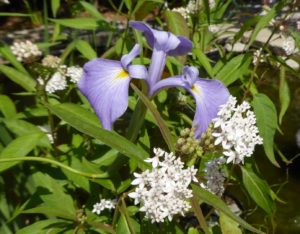
Feeling the need for more water (the small creek along the edge of our property is ephemeral) we decided to add a water feature to our garden. In the quest to resacralize our back yard as sanctuary, I wanted to create a serene contemplative space, a place to focus my prayers for honoring sacred water. I had no idea it would immediately attract so much wildlife!
We began our adventures in water gardening a few years ago by sinking a small round tub into the ground to receive the runoff from one of our rain gutters. We filled this little rain basin with pots of native wetland plants — pink turtleheads, white lizard’s tails, blue flag irises, and tall white-top sedges. We enjoyed this little water garden so much we decided to make a larger, eight by eleven foot wildlife pond right off our back deck.
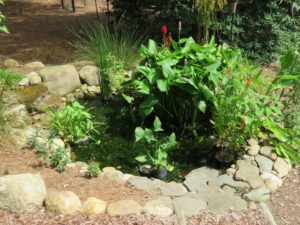
We filled the new pond in mid-May. A few nights later, after rain and a late dinner on the deck, we stood there in the dark overlooking the water, listening to the loud croaks of four Fowler’s toads and the occasional crazy cackles of southern gray tree frogs. These harsh voices totally contrasted with the long, limpid trills of several American toads, resonating and harmonizing their voices sweetly. In the background spring peepers were peeping in the resuming soft rain, while a cricket frog made his marble-knocking calls, trying out varying rhythms from slow to dizzyingly fast. Along with a few fireflies, it sure felt wild out there! It was as if a secret enclave had gathered, enclosed and enfolded, in the darkness. We finally drew ourselves indoors, delighted with the evening’s entertainment.
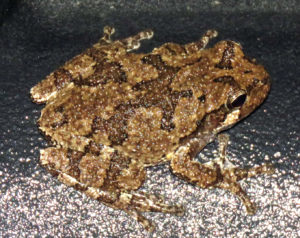
Water creatures began animating the pond by day, and by night the singing of frogs and toads filled the air. We watched a pair of frogs mating in the pond. Two weeks later there were tadpoles. The frogs probably made their way here overland from other ponds in the area, attracted by. . . what, the smell of water? But where did the water striders and back-swimmers come from? It seems like they arrived by magic.
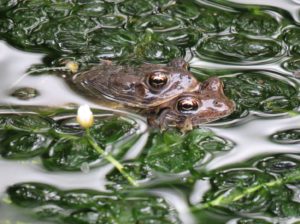
Listening to the frogs made me realize how lonely for wildlife I’d gotten over the colder months. All the winter birds had been present at the feeders, but there were no other forms of life close to us like these water beings. Recently I listened to a talk by Richard Louve, the journalist who identified nature-deficit disorder in his book called Last Child in the Woods. The piece that stood out for me was his saying we are lonely for other species. Yes! He and I are. It’s good to know I’m not alone in this feeling. I get lonely for wild animals; I also get lonely for other people with whom to share this species-loneliness. I looked forward to attracting a community of humans here to help celebrate this community of other-than-human life.
The water reflects all the colors of the sky and shimmers in any unseen breeze. It makes visible all the various rhythms of rain. I love watching the different moods of the rain, whether making great ploppy crown-splashes in hard downpours or lazy widening rings during soft drizzles.
For about two weeks all was quiet, then one night in mid-June it rained an inch, and there was such an amazing cacophony of toads and tree frogs calling that we grabbed a tape recorder to document the orgy. The next night there were even more of them. They were so loud we began to wonder what we’d done to ruin the quiet neighborhood! They continued making an uproar through the wet month of June like this: for a night or two after rain it would grow quiet, then when it would rain again there would be twice as many critters, twice as loud. By mid-July, night was filled with a chorus of katydids and crickets and the caterwauling of tree frogs whose croaks are lower in pitch, sounding like miniature Fowler’s toads.
Sitting on the deck on a blessedly cool and quiet Sunday morning, an electric blue-tailed skink scampers along the top of the sun-warmed pond wall. We watch three frogs alternately sitting on the rocks and swimming in the water. A pair of doves descends to drink at the tiny beach (the frogs retreat into their caves in the rocks). A small rabbit ambles by, and a chipmunk appears and quickly disappears into the shrubs. A hummingbird nectars nearby on the last of the red bee balm, while a red-bellied woodpecker pecks out insects loudly on the red maple above us. Two squirrels pinch up something on the path below the bird feeders and thrashers take turns drinking at the nearby bird bath. A blue dragonfly dips eggs into the pond. It reminds me of one of those museum dioramas of critters improbably, simultaneously gathered together.
I wanted to introduce native wetland plants to this little wetland, so in went several species of water-loving sedges, white turtleheads, astoundingly red cardinal flowers, golden cannas, and crimson-eyed rose-mallow. I’m getting quite attached to this pond. It has become my early morning “sit-spot.” Savoring the morning breeze, I feel blessed by the translucent, stained-glass greenness of the plants’ leaves back-lit by the rising sun, as a wood thrush gloriously greets the morning with me. Often a brilliant red summer tanager calls from high up in the maple, while his wife comes down to eat suet from the feeder that hangs on the nearby dogwood. Bees arrive to gather pollen from the lavender flowers of pickerelweed, as the cicadas start up their long, delicious summer trills.
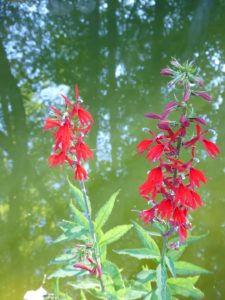
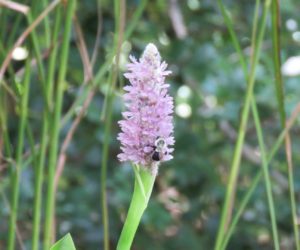
An American snout often arrives to sit on a plant stem in the pond. This small butterfly seems to like being around water and around people. She often lands on our arms for many minutes, to lick salt, I guess. One day I saw a sweet little snout float from its perch on a leaf down onto a rock. In the blink of an eye a wren hopped over and ate it. It happened so fast I was left with the impression that the butterfly had willingly sacrificed itself to the bird.

My husband’s morning ritual, before feeding the birds, is to go out on the deck with his coffee and count frogs. By the end of July the population has risen to eighteen. At dusk, after more rain, the pond is again full of the crazy clamor of the gray tree frogs. The squishy sounds of one or two southern leopard frogs have joined the twang of green frogs and the thrum of a bullfrog. The green frogs are my favorites, because they let you sit on the rocks within inches of them, completely unperturbed, seeming to enjoy the company. One day my husband watched the bullfrog eat a small green frog. I hope they can coexist. There does seem to be a kind of territoriality developing from one end of the pond to the other.
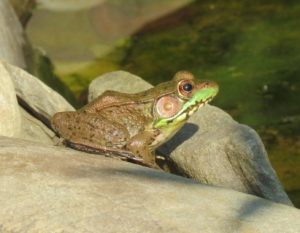
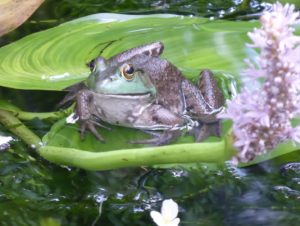
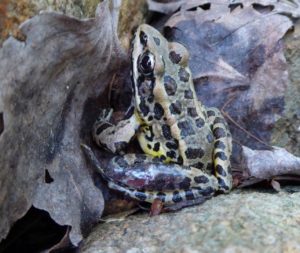

I have been deeply moved by the many holy wells we have visited in Ireland and by the Irish pilgrims who honor their water sources as sacred, as places of healing. I feel the presence of my indigenous Celtic ancestors who revered water, and I’m grateful that the Irish people continue to model for us how to consecrate water that issues from deep in the earth as holy. Perhaps because of their hallowing, it’s easy to envision this pond as symbolizing a holy well, a sacred Source. After all, the small waterfall is only a few yards from our wellhead. Our drinking water rises graciously from the Mother’s underground stream, so it’s possible to imagine the water that flows through rock crevices below and the water falling from rocks above as one.
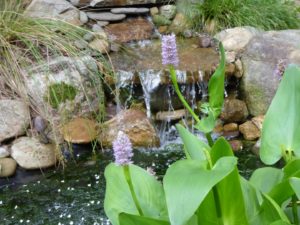
Many Irish holy wells bubble up from their underground sources as springs. When we added a solar bubbler to aerate the pond for the critters, we realized that it looks for all the world like a bubbling sacred spring. This living water arising from the subterranean realm resonates fluently with both the inner symbolic waters of dream life and the outer fresh waters that we are all learning we must honor and protect. The pond is indeed evocative of an oracular sanctuary, a portal to the wisdom of the Below. I sit beside it watching for a vision to arise or listening for a lilting song to emerge.
In the meantime, I am reminded of the Starhawk community’s freedom-fighting song to Brigid, deity of my Irish ancestors, “We will never, ever lose our way to the well of her memory; and the power of her living flame, it will rise, it will rise again, like the grasses, from the dark through the soil to the sunlight, we will rise again. We are thirsting for the waters of life; we are moving; we shall live again.” Our ceremonial community has sung this many times while pilgrimaging to a local sacralized spring. Singing it now, when millions are marching for racial equality and justice, feels especially poignant.
We have enjoyed this back pond so much we decided to make another one with a solar fountain at the front entrance to the garden for the neighbors, recalling those lovely garden fountains that are graciously hearable, if not seeable, by passersby along the streets of Charleston. Soon after it’s filled, the zigzag strings of toad eggs appear. A week or so later the eggs hatch, and the water is animated by a thousand tadpoles.
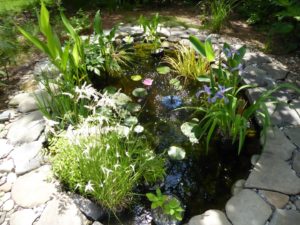
It’s lovely to see the garden through the eyes of a friend who happens to be a poet. Viewing it for the first time, Brian said that the smooth, rounded rocks surrounding the new pond seem timeless. And that the orderly stacking of the rocks lining the inside of the pond reminded him of an old well, maybe one like at an old homestead’s spring in the woods, that it evokes archetypal associations.
The pink water lilies blooming in this front pond enhance this sense of timelessness. Water lilies are one of the two earliest flowering plant families. Fossil records of these plants’ ancestors date back to the Cretaceous, 115 million years ago, when dinosaurs roamed and the supercontinent Pangaea was still in the process of rifting apart. They bring a feeling of being part of a continuity of connection stretching way back in time.
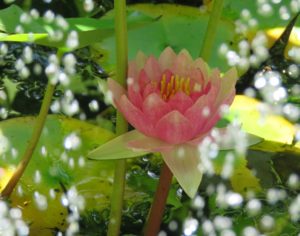

Sitting at the new pond one early June morning, I noticed something strange. First one, then two, then three pale dragonflies were climbing out of the pond onto the rocks. These were adults just emerging from their aquatic larval stage. A dragonfly’s life begins as a nymph living in fresh water. These are called naiads. In Greek mythology, the Naiads are beautiful female nature spirits, nymphs of Artemis. They watch over bodies of fresh water such as streams, fountains, wells, and springs. Those fresh waters which were believed to cure diseases or provide prophetic or poetic inspiration were enshrined for veneration, as at Delphi. “Water nymphs were also worshiped along with Dionysus and Demeter as giving life and blessings to all created beings.”1 Surely we have lost something when our bodies of fresh water are no longer animated by a spirit, protected by a deity. Come to think of it, Irish holy wells are each under the protection of a patron saint, and, mythologically, imbas, poetic revelation, bubbles up from them. (Read Hazelnut Wisdom here)
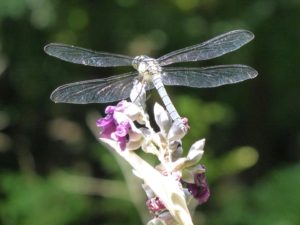
Even older than water lilies, large dragonfly ancestors lived 325 million years ago. Loss of wetland habitats is threatening dragonfly populations world wide. We have dragonflies to thank for our lack of mosquitoes, but, alas, as an integral part of the food chain, they are also known to eat some of the moths, butterflies, and damselflies we love. Their larva feed the newts and frogs in our pond, and the larger nymphs can eat tadpoles. Such is the mutually nourishing web of life.
Frogs themselves are 265 million years old. Over a hundred species have become extinct from environmental toxins since the 1980s, and a third of those remaining are threatened with extinction.2 If any of us can play a small part in giving them a place to thrive, let’s do so. And, while we’re at it, let’s invoke the freshly re-empowered spirits of water to watch over them. They are surely needed and would return if passionately called upon, as they once responded to the indigenous ancestors of this land, and still do, to the native peoples who remain to love them.
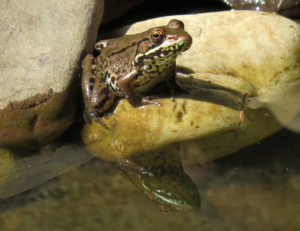
It is increasingly clear that I and others are having a trauma response to the extinction crisis. It’s as if our non-human family is getting killed off right before our eyes. I, for one, am reacting hyper-vigilantly, needing to know how many of my non-human kin are being hurt by the ecological damage we have created, needing to check on what new thing this administration is doing to remove environmental protections, sell off public lands, and push pipelines down the throats of Native Americans.
The bubbling water is soothing to my overactive nervous system, but, if that’s all it is, it would not be the living water I desire. To welcome life we must also be able to welcome the natural death that accompanies it. There are frequent pond dramas. One morning I watched first one and then two more ants in succession fall into the pond and seem to struggle. I rooted for each of them to quickly flail their little legs back to the safety of the edge. But, instead, with bated breath, I watched for many minutes as all three made their way all the way across the pond. Another time I was looking at a frog sitting on a rock when something fell down from the fig tree above and thrashed around in the water. It was a hummingbird moth. I watched, relieved, as it climbed up on a plant. Instantly the frog jumped in the water, emerged and snapped up the large moth.

Another day, my husband was sitting at the back pond when, in one smooth arc of motion, a hawk swooped down and lifted off with a frog. A month later I looked out the window and saw something dark at the edge of the pond that wasn’t there before. A black rat snake was eating a frog! When David ran towards it to. . . to what? . . . it vibrated its tail, jerked towards the big intruder, and the frog made a prodigious leap into the water. The snake slithered behind the waterfall rocks. Oh my. We have unwittingly created a snake hiding place from which he can emerge to catch dinner anytime he wants! Our friend, Jerry, who is a herpetologist, told us that for sure the pond would attract snakes, but that he’d for sure not get rid of it for that reason.
This is yet another event that would have happened without my witnessing it, if I hadn’t happened to look from window to pond exactly then. Frequently I find myself wondering what else is happening out there in the garden, no doubt all sorts of wild interactions that are unseen, unmarvelled at, while I remain indoors writing!
A few weeks ago in mid-July, after voicing my morning prayer of gratitude to the sun in the medicine wheel, I felt an urge to begin making sounds on each out breath. As I walked towards the front pond I began a shamanic-like whistling. Suddenly I came upon a never seen before, magnificent long-tailed skipper nectaring on the lantana. There was a feeling that I had “spoken to” the spirits in the whistling, and the gorgeous skipper was the visible reply. When I praise the sun, I pray that my heart be filled with its goodness, so that I can resonate with all the love and goodness in the natural world that surrounds us. The atmosphere felt charged, enlivened. It seemed like the skipper emerged from that field of goodness, was a gift from the Great Benevolence. It was hot. I was outside for only a short time, and if I had not gone out at that exact moment I wouldn’t have seen that emergent beauty. What a blessing!
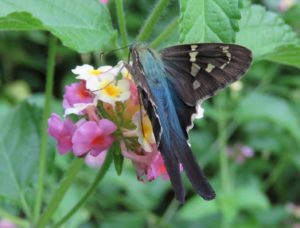
Over the next several days I went out repeatedly to look for the long-tailed skipper. I never did see him. They are rather rare here, so I quite possibly might never see one again. Life is full of such moments in which one sees something amazing, and it remains a special memory, rather than a recurring source of companionship. This was a gift of the Mystery that was correlated with, if not caused by, whistling to the spirits of this place. It was a taste of being in the energy field that animates something out of nothing, the seen out of the unseen. The Mystery not only comes alive in our imaginations; it comes alive in the natural world, too.
With the loss of biodiversity, the fewer animals there are, the less we can experience such wonder, and the less we can know or remember that such manifestations are possible. We are on the verge of losing all memory of the myriad, magical moments that occurred when we were imbedded in a healthy natural world. Now we travel far away to visit special places in which such an encounter might happen. But when we are present here, now, this sense of wonder can still arise in our own parks and gardens. If an apparition is real does that make it any less wondrous?
I have always been intrigued with wetlands, those liminal places that are part land, part water, so I enjoy learning some of their secrets. I observe that after flowering, each water plant, like arrow arum, bends its stalk down to precisely deposit its seeds in the water. The pickerel weed produces seeds prolifically, so I welcome the excuse to get into the pond to remove the extra seeds, which shatter exuberantly in my hand. A friend gave us some elodea from his pond. It’s a plant that, like water lilies, floats on the surface but also extends roots down to the mud below. The pretty white flowers bloom all summer long. Now the frogs don’t have to swim across the pond, they blithely hop across it on the elodea, adding new meaning to “walking on water!” Its green fronds are so abundant we gratefully harvest it to add to our compost and apply it as mulch on our vegetable garden beds.
In the midst of political and social unrest, with 177,000 people in the US dead of Covid, these little wetlands comfort me. The shimmer of the dark water, the bright reflection of brilliant patches of white clouds and blue sky, the serene green mirroring of the trees, soothe my stress. We all need ways to calm our nervous systems in the midst of this trauma, so that we can be clear on the actions we need to take in order to offer firm yet loving response.

It’s mid-August. I sit at the ponds watching the succession of blooming plants and their pollinators. The lavender pickerelweed feeds bees. The red cardinal flowers feed hummingbirds, and the huge scarlet hibiscus flowers feed tiger swallowtails. The flowers and their pollinators perfectly fit one another. The swallowtails arrive in a steady stream. One after the other they slurp the nectar, then hang on a petal a while, as if drunk, before flying off. I draw the hibiscus with swallowtail and the golden canna flowers being pollinated by the bees. After the pods dry I gratefully collect the perfectly round dark seeds of the canna, leaving some for the birds. The seeds are used by the Seminoles to fill their turtle shell rattles. When we visited the Wisconsin Ojibwe reservation of my husband’s ancestors last summer we bought a turtle shell with which to make a rattle. There is an intimacy that comes with making a ceremonial object from plants and animals that give themselves to the people. I look forward to shaking this rattle in ceremonies to pray for healing.


Bitten by this water bug, we are in the midst of digging a new pond. It is to be a vernal pool down by the creek, in hopes of attracting salamanders this winter. I highly encourage you to make a small pond or tiny rain basin if you possibly can, and, if you do, the closer to your porch or patio the better!
1. https://www.theoi.com/Nymphe/Naiades.html
2. https://en.wikipedia.org/wiki/Frog
Text and drawings (C) 2020 Betty Lou Chaika, Photos (C) Betty Lou and David Chaika
All photos taken at Temenos Garden Sanctuary.
Steve Schlosnagle
Thanks for sharing wonderful observations, writing, and photographs on the natural environment you’ve co-created with your pond. I’m inspired to work at developing my own little pond. Can you provide some citations for appropriate reference and guidance? Keep up your good work! May the Forest be with us!
Betty Lou Chaika
Steve, how nice to hear from you! A friend helped dig the holes for the ponds and move the rocks. He also put in the pump for the small waterfall. We knew we needed to add a pond liner and below that a felt underlayment to keep out tree roots. Other than that we really didn’t know what we were doing, just winged it. We watched some youtube videos to get basic ideas. Our back pond was quite challenging because of the slope and the waterfall. I’d suggest choosing as flat a spot as possible. The solar bubbler and little fountain in the front pond are simple and pleasing. You can even put in a pre-formed pond. We have a friend who installed a round one that she is quite happy with.
Laurie Lindgren
So fascinating and nourishing, your ponds and pools and wild friends and the beautiful portal of your language, photography, and drawings to entice me into the Wild World of Water and enable the multidimensional experience of the direct enjoyment of your piece combining with the worlds of plants, animals, weather, water, rocks, soil, flowing, and being. Reading, viewing, seeing, imagining the sounds, the sights, the smells, the experiences continuously flowing into your purview and now mine.
I enjoy two ephemeral ponds in our back yard, and I adore the loud cacophony of the frogs. Isn’t it a miracle how they find it so quickly? And now the cicadas and the crickets. I think I most loved the photos of the frogs in your piece. I’m impressed that you know all their names and sounds. And yes, the wheel of life goes round and round.
Thank you, as usual, for this dedicated gift and offering to Mother Nature.
Much love,
Hayat Laurie
Betty Lou Chaika
Thanks for your enthusiasm and encouraging response, Hayat. I’m pleased that you enjoy and value ponds and wetlands as much as I do. I’ve always been impressed with how you know the medicinal properties of all the plants! Thank you for being a loving friend of the Wild World.
Donna Deal
Such beautiful writing, and photography. I’m transported.
Betty Lou Chaika
Donna, thanks for reading and letting me know you liked the story and photos.
ann loomis
Betty Lou, your pond story with the wonderful photos and drawings fills me with awe and wonder for the diversity of the natural world. It inspires me to look more closely. I also love David’s birthday card!
Betty Lou Chaika
Thanks, Ann. Yes, the biodiversity with which we have been entrusted by the Creator is incredible, and we need to appreciate it, honor it, love it so that, hopefully, we don’t lose more of it through lack of awareness and neglect. Yes, the frogs themselves instigated and created that card!
Diantha Rau
Thank you so much for transmitting pond, plant and critter energy so vividly into my sphere here, just a few miles from your home. Hmm. My yard suddenly appears barren somehow, although our half acre pond just behind the house provides many layers of frog music. In June, they bless us with their annual all-chorus concert. A friend usually visits from NJ each June and always brings earplugs in order to sleep!
Much love to you, Diantha
Betty Lou Chaika
Diantha, I’m sure you have lots of life in your lovely pond. Yes, the frogs and toads can sure be loud! Wonderful musician that you are, I smile to imagine you hearing “layers of frog music!”
Diantha Rau
PS: The photos and drawings are spectacular!
Betty Lou Chaika
Diantha, dear, your encouragement means a lot to me!
Sharon Blessum
I appreciate how you let us in to such intimate intimate experiences, like your morning prayer to Grandfather Sun and the shamanic whistling. Makes me wonder if youve had shamanic training cuz I know that sound😘
Betty Lou Chaika
Hi Sharon, thanks for your feedback that sharing some personal aspects of my practices works for you. I have had a small bit of shamanic training, but mostly training in animism and ancestral healing. For twenty years I have done Authentic Movement with a group (although we are not currently meeting re Covid.) My experience has been that when I drop into my body and move in the imaginal realm I often naturally start sounding and whistling. Yes, I bet you know that sound!
Sandra
Betty Lou, I feel I can relate to the wonderful wild animals who have arrived at your ponds to feed and have life, so nourished am I, having arrived at the edge of your words and images and having plopped right in to bathe and feed my soul. You are a righteous channel for messages from the deeper, higher, wider wild worlds to us who need to hear. Thank you so much, with love.
Betty Lou Chaika
Thanks so much, Sandra, for plopping right in to join the chorus of us peepers who celebrate and want to share our love for and co-creativity with the natural world that nourishes our souls!
Karen Rossie
Thank you for your writing on ponds, Betty Lou. It reminded me of my own pond experiences and amplified the treasured memories and my awareness of the importance of this ecosystem. With gratitude to you and the water critters!
Betty Lou Chaika
Hey Karen, I’d love to hear your memories of your own pond ecosystem. I’m glad that we share love for the water critters and for all the local animals. Thanks for letting me know you liked the story.
Marj Marie
Thank you, thank you, thank you for sharing your wild wet water experiences. I feel as though I’ve been there with you. What a gift you two have given to so many creatures. Who is blessed more, you or them! I love the many circles of life you so lovingly describe. David’s photographs are very beautiful to go along with your keen observations and wonderful capturing in words. Thank you to both of you for holding the light for ALL.
Betty Lou Chaika
Oh, Marj, it’s so good to have these opportunities to be in contact with you. It’s sweet to imagine your being with us at the ponds. Yes, it is a good question who is blessed more. The blessings are mutual, for sure. I dearly hope that we can continue, in your lovely phrases, “to hold the light for the many circles of life.” That would be my greatest desire and highest calling.
Barb Stenross
I so enjoyed reading this and taking in the gorgeous photos and your artwork, which I think is more wonderful than ever! I also am impressed by your recognition of frogs by sounds and sight. And how did David get them to pose like that?! (I’m chuckling here.)
I remember your original small pond, and ever since I saw it, thought I should try that. Time passed and I didn’t. But this summer when you challenged me to give it a try, I did. For those interested, it was not particularly hard–hardest was hauling and stacking stones around the sides of the pond. Our pond is round plastic , about 44 inches in diameter. We placed it in what was once an ephemeral stream bed that only rarely has water in it because Carrboro rerouted the stream. I put rocks and gravel in the bottom of the pond, and added bricks and stones on which to place pots of plants. Some pots sit at the bottom because the plants can be in water all the time (e.g., lizard’s tail). Others are higher up, in just a bit of water (e.g., cardinal flower). Two things to consider: make sure the pond is free of forever chemicals (unfortunately, I am not sure mine is, although it was sold as a “pond,” so I am hoping so); and use water that has been filtered of chlorine and chloramines (I purchased a filter I can attach to the hose for about $50 from a pond supply store). Betty Lou gave me some marvelous elodea.
I wasn’t expecting to get a frog, but sure enough, after about two weeks, one showed up. I watched it for a week as it sat on the pond rim, or on one of the rocks, then jumped into the water if I got too close. I am thinking it was a tree frog, although I couldn’t get close enough to see it well, or get a good photo. Then it disappeared, and I missed seeing it. Ten days or so later, another showed up, although I have only seen it once. Or maybe it was the same frog?
Having a little pond is captivating. It has become a “destination” in my half-acre yard! Not only for me, but also I hope, for many wild friends that I haven’t yet seen. If you are thinking of trying a pond, go for it!
Betty Lou Chaika
Thanks, Barb, for the kudos on this labor of pond love. Also, thank you for providing the tips and encouragement for folks to make their own small ponds. I’m so happy that you went ahead with making yours and are pleased with the results. The best is yet to come as the critters continue to arrive to be blessed by your care for them. I’m sure you, too, will come to know them all.
Laurel
How wonderful to read you enlightening musings and how it stirs my longing to spend more time in nature .
I love your ponds and their beauty. I grew up across from a small lake and then moved across state to small mountain where there were 2 ponds on either side of our driveway. The frogs were so raucous that we bought ducks to feed on the tadpoles! I do miss all the water features of my childhood so!
Thank you so much for your eloquent sharing. I am using this time to grow more herbs and food and that keeps me grounded and settled some of the time 😉
Betty Lou Chaika
Laurel, it’s sweet to hear your memories of how much your childhood lake and ponds meant to you. We had no idea how attached we would become to these ponds and to the abundance of critters they support. We finally put in a much needed deer fence, so I can agree with you on how much grounding growing vegetables provides. Blessings on your garden. Thanks for letting me know you enjoy these writings.
susanne jackson
Betty Lou, I’ve been looking for you as I walk by your house and garden to tell you how much I enjoyed your narrative, photos and drawings of your pond and garden. I love frogs and knew we had a variety of them here in NC, but had no idea of all of the different species that are in our back yards if I took the time to look for them. Your botanical illustrations are fantastic!
Betty Lou Chaika
Thanks, Sue, for reading Pond Love and letting me know you enjoyed it! Perhaps I can encourage you in your painting, too!